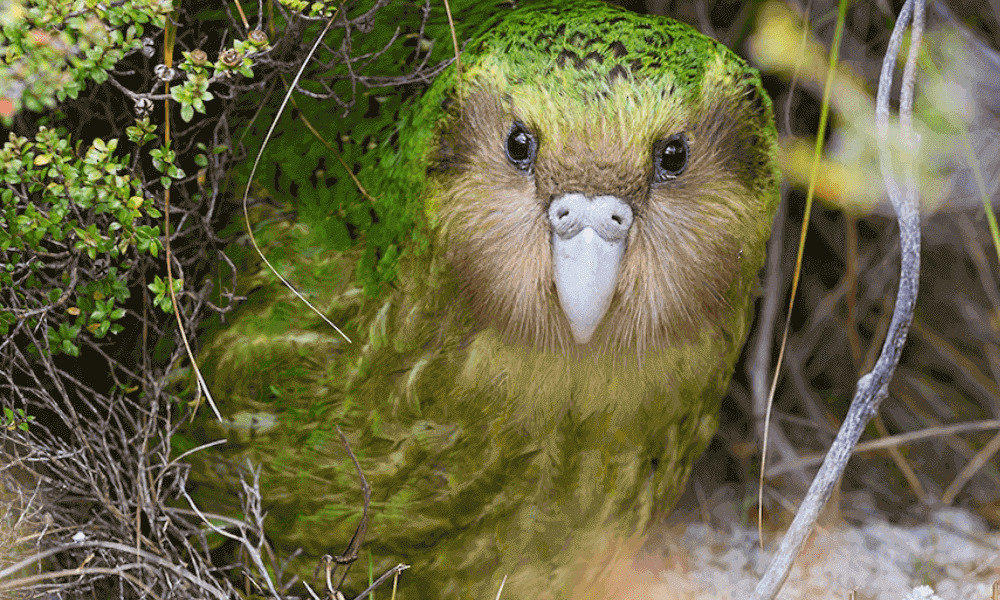The Kakapo ranks among the rarest and most extraordinary birds on Earth. This parrot, native to New Zealand, holds a unique title—it stands as the world’s heaviest parrot and lacks the ability to fly. Sadly, conservation authorities have placed the kakapo on the Critically Endangered list, which means it faces an extremely high risk of extinction.
Where Is the Kakapo Found?
This is a rare bird found only in New Zealand. Due to their endangered status, all surviving Kakapos have been relocated to predator-free offshore islands for protection.
Physical Characteristics of the Kakapo

The kakapo shows many amazing physical features. First of all, it weighs between 2 to 4 kilograms, which makes it the heaviest parrot in the world. In fact, no other parrot comes close in weight. Moreover, it has mossy green feathers with yellowish tones, which help it blend easily into forest surroundings. As a result, it stays hidden from predators.
In addition, the Kakapo depends on its strong sense of smell to find food at night. Unlike most birds, it cannot fly. This happens because its wings are too small and its body is too heavy. However, the kakapo moves well on the ground and climbs trees using its claws and beak. Besides this, it often uses hopping as a way to travel through the forest floor.
Most importantly, the kakapo lives for over 60 years, which makes it one of the longest-living birds. Overall, these unique traits make the kakapo truly rare and fascinating.
Behavior and Diet
This bird is nocturnal, meaning they are active at night. It primarily feeds on leaves, fruits, seeds, and flowers. Unlike most birds, the Kakapo relies heavily on its sense of smell to find food.
💔 Why Is the Kakapo Critically Endangered?
Several serious threats have pushed these birds close to extinction. Firstly, humans introduced predators like cats, rats, and dogs to New Zealand. These animals attacked the kakapos, especially since the birds cannot fly. Secondly, people destroyed large parts of the birds’ natural forest habitat to make space for farming and cities. As a result, the kakapo lost the shelter and food it once had in the wild.
Another major issue is its slow breeding cycle. This bird reproduces only once every 2 to 4 years, and even then, only when certain native trees produce fruit. This slow and rare reproduction makes it very hard for the population to grow. Because of all these reasons, the bird now faces a very high risk of extinction.
you interested in the Scarlet Macaw
Conservation Efforts to Save�
It shows many amazing physical features. First of all, it weighs between 2 to 4 kilograms, which makes it the heaviest parrot in the world. In fact, no other parrot comes close in weight. Moreover, it has mossy green feathers with yellowish tones, which help it blend easily into forest surroundings. As a result, it stays hidden from predators.
In addition, the species depends on its strong sense of smell to find food at night. Unlike most birds, it cannot fly. This happens because its wings are too small and its body is too heavy. However, it moves well on the ground and climbs trees using its claws and beak. Besides this, it often uses hopping as a way to travel through the forest floor.
Most importantly, it lives for over 60 years, which makes it one of the longest-living birds. Overall, these unique traits make the birds truly rare and fascinating.
Interested in free donuts? So get Dunkin’ samples here
Conclusion
It’s more than just a rare bird—it’s a symbol of how fragile and precious our natural world is. Its unique characteristics make it a wonder of evolution, and its story reminds us why wildlife conservation matters. The future of the Kakapo now depends entirely on human awareness and action.
Fall in love with the kakapo—the world’s heaviest, flightless parrot from New Zealand. A rare bird you’ll want to protect before it’s gone forever.

Leave feedback about this